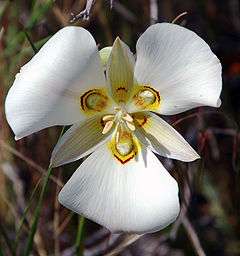Calochortus nuttallii
Calochortus nuttallii — known as sego lily — is a bulbous perennial which is endemic to the Western United States.
| Sego lily | |
|---|---|
 | |
| Scientific classification | |
| Kingdom: | Plantae |
| Clade: | Tracheophytes |
| Clade: | Angiosperms |
| Clade: | Monocots |
| Order: | Liliales |
| Family: | Liliaceae |
| Genus: | Calochortus |
| Species: | C. nuttallii |
| Binomial name | |
| Calochortus nuttallii | |
| Synonyms[1] | |
| |

Distribution
The plant is native to a number of western states, being found throughout Utah and Wyoming, large parts of eastern Nevada, and parts of Idaho, Montana, North Dakota, South Dakota, Nebraska, Colorado, Arizona, and New Mexico.[3][4]
Description
.jpg)
Calochortus nuttallii are around 15–45 cm (6–18 inches) in height and have linear leaves.[3]
Plants have 1 to 4 flowers, each with 3 white petals (and 3 sepals) which are tinged with lilac (occasionally magenta) and have a purplish band radiating from the yellow base. A yellow petaled form with deep purple bands is known from Petrified Forest National Park.[5] The yellow petaled form was also observed in a "super bloom" near the Orange Cliffs District of Glen Canyon National Recreation Area, on the north side of the Colorado River near Hite, Utah in May 2019. The plant blooms in early summer, with flowers that can be up to 3 inches across.[6][7]
Taxonomy
Calochortus nuttallii is a species within the genus Calochortus, in a sub-group generally referred to as Mariposa Lilies. The specific epithet nuttallii, named for the English botanist and zoologist, Thomas Nuttall, was ascribed to the species by the American botanists John Torrey and Asa Gray when it was officially described in 1857.
A number of former varieties of Calochortus nuttallii have been reclassified as distinct species:
- Calochortus nuttallii var. aureus (S.Watson) Ownbey is currently Calochortus aureus S.Watson
- Calochortus nuttallii var. australis Munz is currently Calochortus invenustus Greene
- Calochortus nuttallii var. bruneaunis (A.Nelson & J.F.Macbr.) Ownbey is currently Calochortus bruneaunsis A.Nelson & J.F.Macbr.
- Calochortus nuttallii var. leichtlinii (Hook.f.) Smiley is currently Calochortus leichtlinii Hook.f.
- Calochortus nuttallii var. panamintensis Ownbey is currently Calochortus panamintensis (Ownbey) Reveal
- Calochortus nuttallii var. subalpinus M.E.Jones is currently Calochortus leichtlinii Hook.f
Uses
Culinary
Native Americans had culinary uses for the bulbs, seeds, and flowers of the plant. Bulbs were roasted, boiled, or made into a porridge by the Hopi, Havasupai, Navajo, Southern Paiute, Gosiute, and Ute peoples.[9][10][11] The Hopi used the yellow flower ceremonially.
They taught the Mormon pioneer immigrants to use the bulb for badly needed food. This resulted in the sego lily being formally designated as the Utah State Flower in 1911.[12]
Cultivation
Calochortus nuttallii is cultivated as an ornamental plant for its attractive tulip-shaped flowers and to attract/support native pollinator species.[13] It prefers a deep, sandy soil with good drainage, and is cold-hardy. Plants can be propagated from newly formed bulblets which take two years to flower.[14]
References
- Kew World Checklist of Selected Plant Families
- Source: "Our State Flowers: The Floral Emblems Chosen by the Commonwealths", The National Geographic Magazine, XXXI (June 1917), p. 512.
- "Calochortus nuttallii". Flora of North America. eFloras.org. Retrieved 2007-11-12.
- "Distribution Map". Flora of North America. Retrieved November 30, 2018.
- Northern Arizona University: Petrified Forest Nat'l Park, Arizona. Yellow Sego Lilies (Calochortus nuttalli)
- NPIN: Calochortus nuttalli
- "Extension.usu.edu: Range Plants of Utah − Sego Lily". Archived from the original on 2015-06-26. Retrieved 2015-05-03.
- "Calochortus nuttallii". electronic Plant Information Centre (ePIC). Royal Botanic Gardens, Kew. Retrieved 2007-11-12.
- University of Michigan at Dearborn: Native American Ethnobotany of Calochortus nuttallii
- "Mariposa Lily (Calochortus nuttallii)". Native Wildflowers of the North Dakota Grasslands. Northern Prairie Wildlife Research Center. Retrieved 2007-11-12.
- Chamberlin, R.V. "The Ethno-botany of the Gosiute Indians of Utah" (PDF). Memoirs of the American Anthropological Association Vol II, part 5. Retrieved 2007-11-12.
- "Utah State Flower". Netstate.com. Retrieved 2007-11-12.
- NPIN: Calochortus nuttallii
- "Calachotus nuttalli". Plants for a Future. Retrieved 2007-11-12.